Hull City
The Tigers were formed in July 1904, too late to apply to join a league so the club played friendly matched during their first season, submitting an application to join the Football League the following year. At the time, the Football League's policy was to encourage the development of professional association football in Yorkshire, a stronghold of Rugby League. Hull's application was initially rejected but then it was decided to expand the two divisions by two clubs each, which resulted in four vacancies in the Second Division. On a second ballot, Hull were accepted.
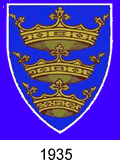 The years leading up to the First World War saw Hull City's strongest League performances and in 1910 they narrowly missed out on promotion to Division 1 on goal average. Between the Wars, Hull carved out a reputation as formidable Cup fighters, reaching two quarter-finals and in 1930 the semi-final. Sadly this last achievement was marred by relegation to Division 3 (North) where they languished for three years. In 1935 the club adopted the city's municipal colours of light blue and white adorned with the coat of arms of Kingston upon Hull only to be relegated once again. The traditional stripes returned the following season although the blue shirts were revived immediately after the Second World War.
The years leading up to the First World War saw Hull City's strongest League performances and in 1910 they narrowly missed out on promotion to Division 1 on goal average. Between the Wars, Hull carved out a reputation as formidable Cup fighters, reaching two quarter-finals and in 1930 the semi-final. Sadly this last achievement was marred by relegation to Division 3 (North) where they languished for three years. In 1935 the club adopted the city's municipal colours of light blue and white adorned with the coat of arms of Kingston upon Hull only to be relegated once again. The traditional stripes returned the following season although the blue shirts were revived immediately after the Second World War.
In 1949, now wearing plain amber shirts with a bold tiger's head badge, City returned to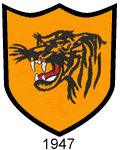 Division 2 and enjoyed another stirring cup campaign, losing 0-1 to Manchester United in the quarter-final. There was little to celebrate during the Fifties and by the early Sixties,
Division 2 and enjoyed another stirring cup campaign, losing 0-1 to Manchester United in the quarter-final. There was little to celebrate during the Fifties and by the early Sixties,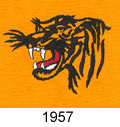 City were in Division 3.
City were in Division 3.
The roaring tiger appeared without a background shield between 1957 and 1960 when it was dropped before it was reinstated in 1971.
After a period wearing stripes once again, an unusual all amber strip with black bands was introduced only to be universally derided by fans who called it the banana-strip. 1966 brought another FA Cup quarter-final and a return to Division 2 where the club stayed until 1978.
1966 brought another FA Cup quarter-final and a return to Division 2 where the club stayed until 1978.
Stripes appeared once more in 1975 when white was introduced to the strip for the first time. The club's initials were embroidered onto these shirts until 1979 when the tiger's head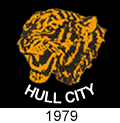 appeared once more. The club always used the suffix "AFC" to distinguish them from the town's two rugby league clubs, Hull RFC and Hull Kingston Rovers RFC.
appeared once more. The club always used the suffix "AFC" to distinguish them from the town's two rugby league clubs, Hull RFC and Hull Kingston Rovers RFC.
The Eighties brought disaster as the club slipped briefly into the Fourth Division. They recovered and climbed back to Division 2, finishing in sixth place in 1986 but then they have slipped down the leagues once again, alternating with some regularity between the lowest two divisions.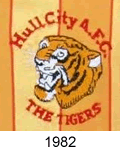
Hull have not been afraid to experiment with their playing kit, including a bizarre tiger-print design adopted in 1992 generally regarded as one of the worst strips of all time. Despite being met with widespread derision at the time, Hull fans became very attached to the outrageous design. When Matchwinner's contract was cancelled in late 1993, the company refused to hand over the design templates to Pelada, who had replaced them as Hull's kit supplier. As a result Pelada produced their own version with a finer print in a sort of dirty brown colour: 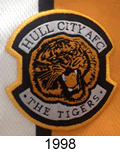 supporters consider this version infinitely inferior to the original.
supporters consider this version infinitely inferior to the original.
In 1998 the club crest was given an overhaul with the addition of the Humber Bridge along with three crowns, the municipal symbol of Kingston upon Hull, as well as a slightly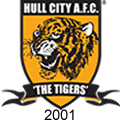 comical looking tiger. This proved unpopular and was retired in favour of a rather more traditional design in 2001.
comical looking tiger. This proved unpopular and was retired in favour of a rather more traditional design in 2001.
In recent years, the club has often consulted fans when choosing a strip for the new season. Supporters have consistently favoured plain amber shirts in the belief that the little success the club has enjoyed has been when they played in plain shirts. Despite this, stripes regularly re-appear, including in 2004, the club's centenary season and a promotion season. Since then support has increased for the striped shirts, not least because they are unique in the top tiers of English football and when Hull gained promotion to the Premier League in 2008, they were adopted for their first ever campaign in the top tier.
The Tigers managed two seasons in the Premier League before they were relegated back into the Championship in 2010.
